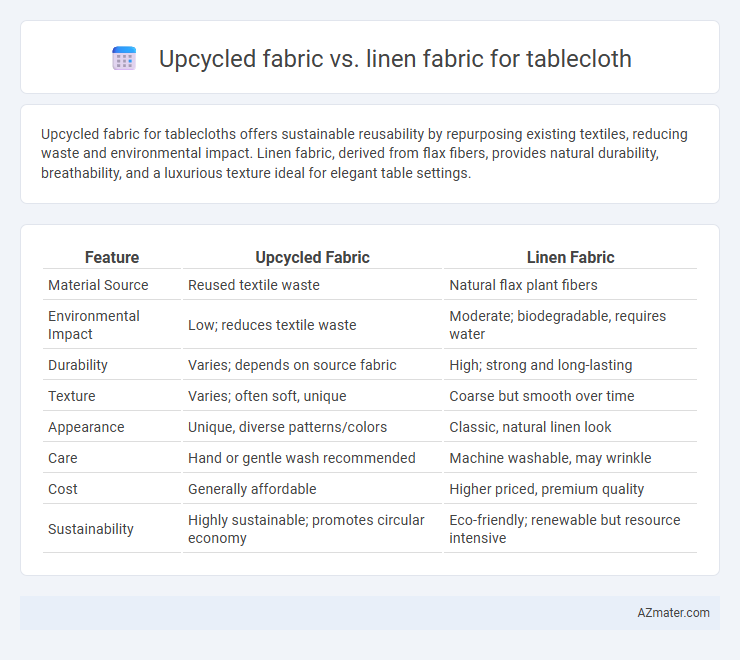Upcycled fabric for tablecloths offers sustainable reusability by repurposing existing textiles, reducing waste and environmental impact. Linen fabric, derived from flax fibers, provides natural durability, breathability, and a luxurious texture ideal for elegant table settings.
Table of Comparison
| Feature | Upcycled Fabric | Linen Fabric |
|---|---|---|
| Material Source | Reused textile waste | Natural flax plant fibers |
| Environmental Impact | Low; reduces textile waste | Moderate; biodegradable, requires water |
| Durability | Varies; depends on source fabric | High; strong and long-lasting |
| Texture | Varies; often soft, unique | Coarse but smooth over time |
| Appearance | Unique, diverse patterns/colors | Classic, natural linen look |
| Care | Hand or gentle wash recommended | Machine washable, may wrinkle |
| Cost | Generally affordable | Higher priced, premium quality |
| Sustainability | Highly sustainable; promotes circular economy | Eco-friendly; renewable but resource intensive |
Introduction to Upcycled and Linen Fabrics
Upcycled fabric, crafted from repurposed textile waste, offers an eco-friendly alternative to conventional materials by reducing landfill contributions and conserving resources. Linen fabric, derived from the flax plant, is prized for its natural durability, breathability, and elegant texture, making it a traditional choice for tablecloths. Both fabrics bring unique sustainability and aesthetic qualities to tableware, with upcycled fabric emphasizing environmental impact and linen highlighting natural fibers and timeless appeal.
Environmental Impact: Upcycled vs Linen Tablecloths
Upcycled fabric tablecloths significantly reduce textile waste by repurposing existing materials, minimizing the demand for new raw resources and lowering carbon emissions. Linen fabric, derived from flax plants, is biodegradable and requires less water and pesticides compared to cotton, making it an eco-friendly option with a renewable lifecycle. Choosing between upcycled and linen tablecloths involves balancing waste reduction benefits with the natural, sustainable cultivation process of linen.
Production Processes Compared
Upcycled fabric for tablecloths involves repurposing pre-existing textiles, reducing waste and resource consumption by minimizing the need for new raw materials, while linen fabric production relies on harvesting flax plants, which requires significant water, labor, and processing to convert fibers into durable cloth. The upcycling process emphasizes sustainability by bypassing conventional manufacturing stages such as spinning and weaving from raw fibers, contrasting with linen's traditional and resource-intensive steps including retting, scutching, and hackling. Environmental impact assessments favor upcycled fabrics for lowering carbon footprint and energy use compared to the relatively high agricultural inputs and chemical treatments associated with linen fabric production.
Texture and Visual Appeal Differences
Upcycled fabric tablecloths offer a unique, textured look characterized by irregularities and a handcrafted feel, appealing to eco-conscious consumers seeking distinctive design elements. Linen fabric, known for its natural, smooth yet slightly coarse texture, provides a crisp, elegant appearance with subtle luster and natural wrinkles that enhance its visual depth. The tactile contrast between upcycled fabrics' varied surfaces and linen's consistent, breathable weave influences both the aesthetic and tactile experience on dining tables.
Durability and Longevity
Upcycled fabric tablecloths offer excellent sustainability benefits but may vary in durability depending on the source material and processing methods. Linen fabric, derived from flax fibers, is highly durable and naturally resistant to wear, making it ideal for long-lasting tablecloths that maintain their quality after multiple washes. Choosing linen ensures superior longevity and strength, while upcycled fabrics require careful selection for comparable durability.
Maintenance and Care Requirements
Upcycled fabric tablecloths often require gentle washing with mild detergents and air drying to preserve their unique textures and colors, as they may consist of mixed or delicate fibers. Linen fabric tablecloths benefit from machine washing in cold or warm water, but should be ironed while damp for a smooth finish and stored carefully to avoid creases and moisture damage. Both fabrics demand attention to stain removal, but linen's natural fiber composition makes it more durable and resistant to frequent washing compared to the often more fragile upcycled materials.
Cost Comparison
Upcycled fabric tablecloths typically offer a more budget-friendly option, utilizing reclaimed materials that reduce production costs compared to new textiles. Linen fabric, known for its durability and natural texture, often comes at a higher price point due to its labor-intensive cultivation and processing. Choosing upcycled fabric can lead to significant savings while supporting sustainable practices, whereas linen provides premium quality and longevity at an increased investment.
Style Versatility and Customization
Upcycled fabric offers unique style versatility for tablecloths through its one-of-a-kind patterns and textures, making each piece distinct and eco-friendly. Linen fabric provides classic elegance and smooth texture, easily customizable with traditional embroidery, dyeing, or printing techniques to fit both rustic and modern decor themes. Both materials support personalization, but upcycled fabric highlights sustainability and originality, while linen emphasizes timeless sophistication and durability.
Sustainable Dining: Eco-Conscious Choices
Upcycled fabric tablecloths reduce waste by repurposing pre-existing materials, offering a unique and eco-friendly option for sustainable dining. Linen fabric, made from flax plants, is biodegradable, durable, and requires fewer resources to produce, making it a natural choice for environmentally conscious consumers. Both options contribute to lowering carbon footprints, but upcycled fabrics emphasize waste reduction while linen prioritizes renewable resource use.
Which Tablecloth Option Fits Your Lifestyle?
Upcycled fabric tablecloths offer eco-conscious consumers sustainable style with unique patterns and durability ideal for casual, zero-waste lifestyles. Linen tablecloths provide natural breathability, elegance, and longevity, suiting those who value classic aesthetics and easy maintenance. Choosing depends on prioritizing environmental impact or timeless texture for your dining setup.

Infographic: Upcycled fabric vs Linen fabric for Tablecloth
 azmater.com
azmater.com